NEWS
10.09.2021
Would Dragon Ball's Gravity Training Really Work? We Asked a Genuine Neuroscientist for Answers!
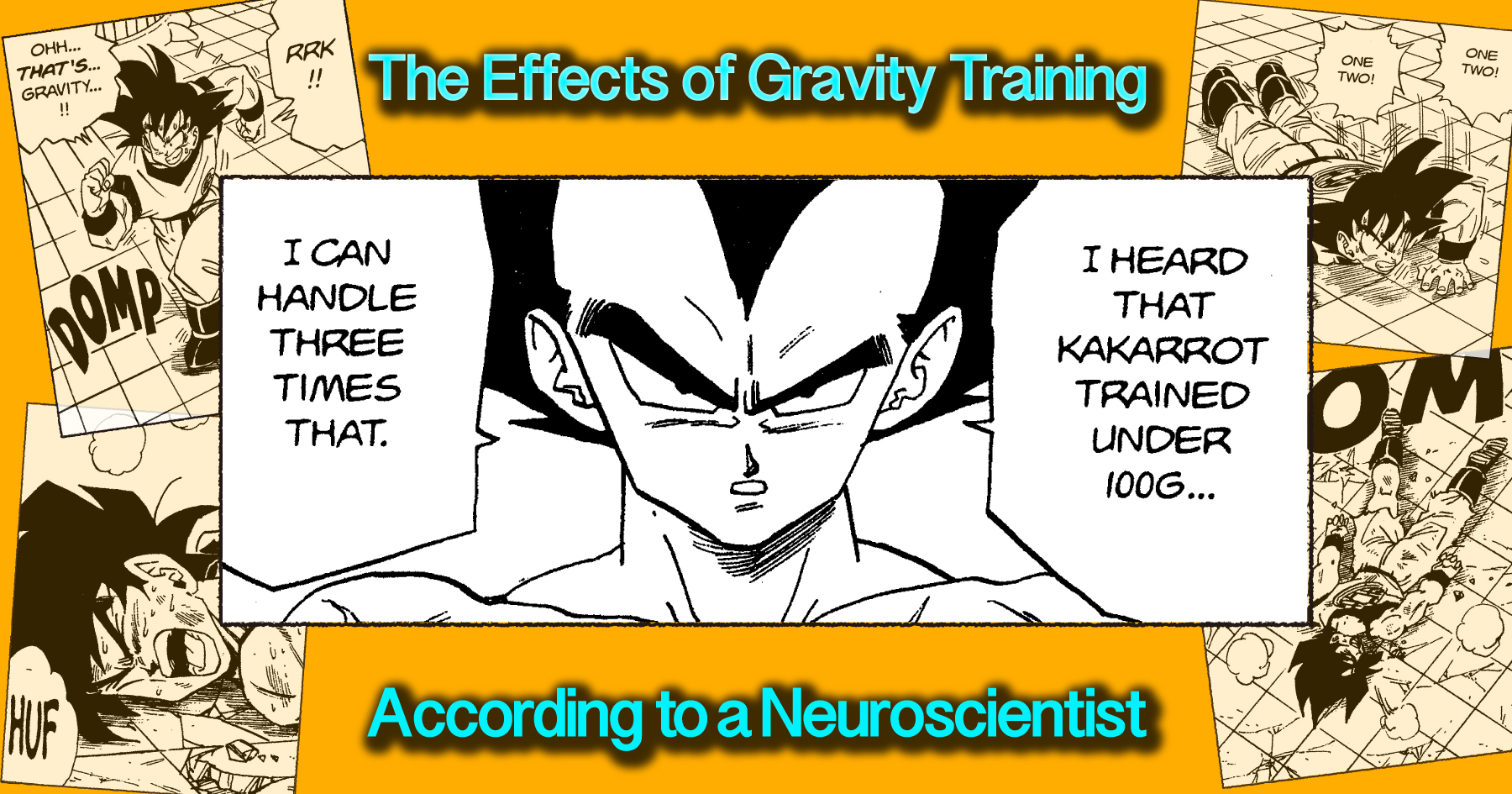
There isn't a Dragon Ball fan in the universe who doesn't know what gravity training is. The 10G on the Planet of the Kaio, the training room on Goku's spaceship headed for Planet Namek, and the Room of Spirit and Time all allow Dragon Ball's mighty warriors to push their limits in a high-gravity environment. As a fellow Dragon Ball connoisseur, I'm sure that right about now your head's swimming with fond memories of your favorite high-gravity training scenes.
But hold your Dragon Balls. Would gravity training work in the real world? Let's say you too endured rigorous training under the weight of an intense gravitational field, would your physical capabilities skyrocket just like Goku and Vegeta's? I'm sure I'm not the only aspiring Saiyan warrior to have wondered such a tantalizing thing. Luckily for us, Professor Yutaka Hirata from Chubu University is here to shed some light on the topic from the perspective of a neuroscientist!
For this article, I was lucky enough to get to pick Professor Hirata's brain about the link between physical ability and gravity. We cover everything from the results of high-gravity simulation tests to the role gravity plays in the body's growth mechanisms and even discuss the scientifically proven conditions for the ultimate form of training! And of course, we'll be tying everything back to Dragon Ball and those iconic gravity training scenes!
Reading this article may not raise your Power Level, but it will certainly improve your intellectual ability! I hope you join me on this mind-expanding mission to get to know, and enjoy, those famous Dragon Ball training scenes even more.
Profile
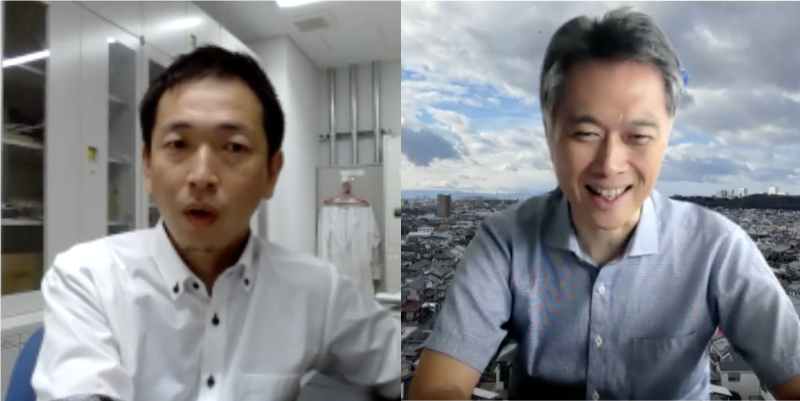
Interviewer, Article: Masayuki Kato (left)
Science teacher and writer. Specializes in biology. A member of the original Dragon Ball generation—attended elementary & middle school during the 10 years that Dragon Ball was being published in "Weekly Shonen Jump".
Favorite scene: when Tenshinhan launches a Mafu-ba at Piccolo.
Being Interviewed: Professor Yutaka Hirata (right)
Dept. of Robotic Science and Technology at Chubu University. Specializes in systems neuroscience & bioinformatic engineering. Gained wider recognition after presenting findings on how high-gravity environments positively influence motor skill acquisition at an international conference in 2018.
Favorite Dragon Ball character: Kamesennin.
*Interview was conducted remotely.
Contents
・ Humans in 100G
・ Are Beings Born on Planets with Higher Gravity Naturally Stronger?
・ What You're Training in High Gravity Isn't Muscles, it's the Brain's Neural Network
・ Unexpected Training Results of the Room of Spirit and Time
・ Revealed: Planet Namek Saichoro's Secret
・ Professor Hirata & Dragon Ball
・ Conditions for the "Ultimate Training"
I'm sure you've had to explain it so many times up until now already, but can you tell us a bit about your area of research?
I research how motor skill acquisition manifests inside the brain. I'm particularly interested in the relationship between gravity and the efficiency of motor skill acquisition. I've actually conducted experiments that prove the positive effect that hyper-gravity (environments that exceed the Earth's gravitational field's strength of 1G) has on motor skill acquisition in humans and goldfish.
So stronger gravity really does help you power up! Dragon Ball was right all along...! By the way, Professor, have you personally experienced higher gravity?
Not to the same extent as Goku and Vegeta, but as part of the experimentation process, I have of course experienced it. I mean, it was only a meager 2G, but still...!
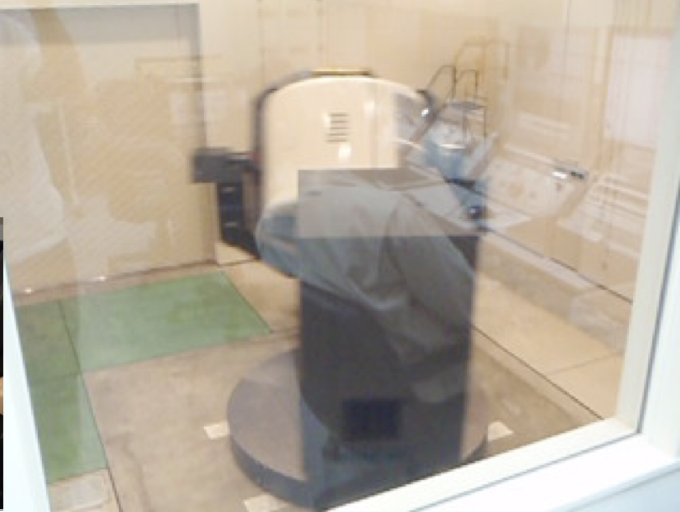
"GYROLAB" equipment used in Prof. Hirata's experiments. Usually used for training pilots at the Japan Air Self-Defense Force's Iruma Air Base. Its high-speed rotation generates centrifugal forces equivalent to up to 3.5G. (Picture provided by Prof. Hirata)
Only 2G, huh? In Dragon Ball they have 20G and even 100G, so to be honest, 2G doesn't sound like much...
Maybe so, but I'm telling you 2G is no walk in the park. Your body weight suddenly doubles, so the strain is immense. Just lifting your arm to scratch your nose is a challenge, and if you don't sit with the right posture, your hips and back start to crumble. And worse, if you aren't careful, the blood flow to your brain slows and you can lose consciousness. We initially started the experiments with 3G, but if all the participants—including me—kept fainting, it would've been pretty hard to make any progress! So, we ended up dropping it to 2G.
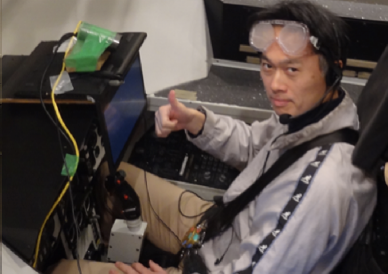
Prof. Hirata strapped into the equipment as a participant in the experiment. (Picture provided by Prof. Hirata)
3G can make you faint?! I guess my next question would then have to be, what would happen to humans if they went into 100G and 300G like in Dragon Ball?!
It would be like having the weight of 100 of yourself placed on top of you, so fainting would be the least of your worries. Your bones would definitely all break!

Dr. Brief in shock at Vegeta's request for a 300G training room
Vegeta withstanding 300G sure was an incredible feat then...!
Let me tell you a bit more about the toll that it would take on the body. Assuming the gravitational force was being applied vertically, then your heart and lungs wouldn't be able to function under the force driving you into the ground, which in turn would stop the blood flow to your brain, so you'd faint. But at the same time, your muscles and bones would take huge damage. So even if you didn't pass out, there's no way you could stand!
I kinda want to see Goku and Vegeta faint!
However, if you drop to all fours, then the downward force gets dissipated, and so, in theory and in practice, the toll on the body somewhat reduces. In the manga, Goku crawls on his belly as he tries to endure intense gravity, right? Goku's way of moving minimizes the impact on his body and was quite ingenious of him.
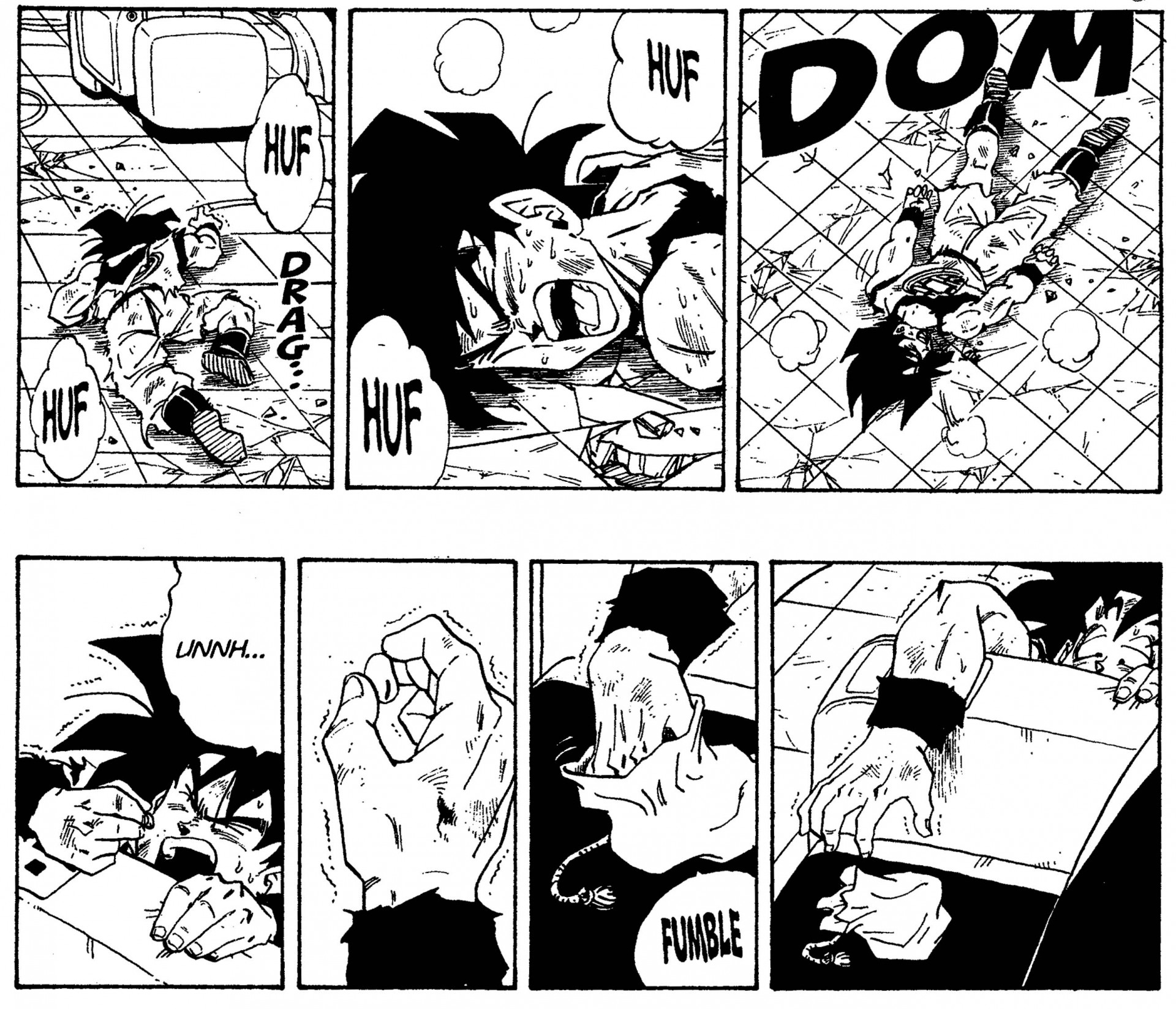
Goku crawling on his belly, reaching for a Senzu bean
This might be a silly question, but would people or animals born and raised in an environment with different gravity look different or have different capabilities? I only ask because when I was young, I read a manga that had a scene showing the protagonist visit a small planet with even weaker gravity than Earth's, and he's seen by the inhabitants as being freakishly strong. That's probably why I was able to accept Dragon Ball's "high gravity = increased fighting ability" set-up at face value.
I think it's safe to say they would become different over time. If the place you live has stronger gravity, then you need more muscle mass to withstand it. I think beings raised in a high-gravity environment would naturally evolve to become stronger than those raised in a low-gravity one.
I see! Now that you mention it, on the Planet of the Kaio, which has higher gravity than Earth, there was a monkey (Bubbles) who was too swift even for Goku to catch. But, speaking as a biologist, there's still something that's bothering me a little.
What would that be?
The fact that body size isn't being considered as a variable. There's a fundamental principle of nature that says: "the potential body size of land-dwelling creatures is limited by the strength of gravity." According to this principle, creatures raised in high-gravity environments will naturally evolve to become smaller. So even if there is a difference in strength, is it not conceivable that, in the end, the being with the physically larger body will prevail?
That's an interesting point. However, I don't think the relationship between gravity strength and body size is quite so simple. Without a doubt, higher gravity would hinder the ability for a species to become larger vertically, but gravity plays far less of a role horizontally—so expanding lengthwise would still be possible. Even if walking upright were impossible, 4-legged creatures could still thrive. Thus, we can say with some confidence that animals like centipedes and lizards wouldn't be affected as much by increased gravity.
So you're saying that, even in a high-gravity environment, animals could continue to evolve and increase in size in a crocodile-like form?
That's exactly what I'm saying, yes.
A crocodile ten times stronger than the ones on Earth... That would make quite the training partner for Goku!
Now that we've come to an understanding about the effects gravity has on creatures' bodies, I'd like to talk about the way gravity can influence the results of training.
Absolutely. Any creature's physical capabilities are intrinsically tied to the brain's ability to master precise muscle movements. So in fact, the quality and quantity of acquisition matters more than the visually obvious muscle mass and overall bone structure. That also happens to be the difference between regular and top athletes. Through training, the brain's neural network optimizes itself to be able to send clearer and more precise commands to the muscles.
Fascinating. So on the spaceship headed for Planet Namek and in the Room of Spirit and Time, you're saying Goku and Vegeta's neural networks were being trained, right?
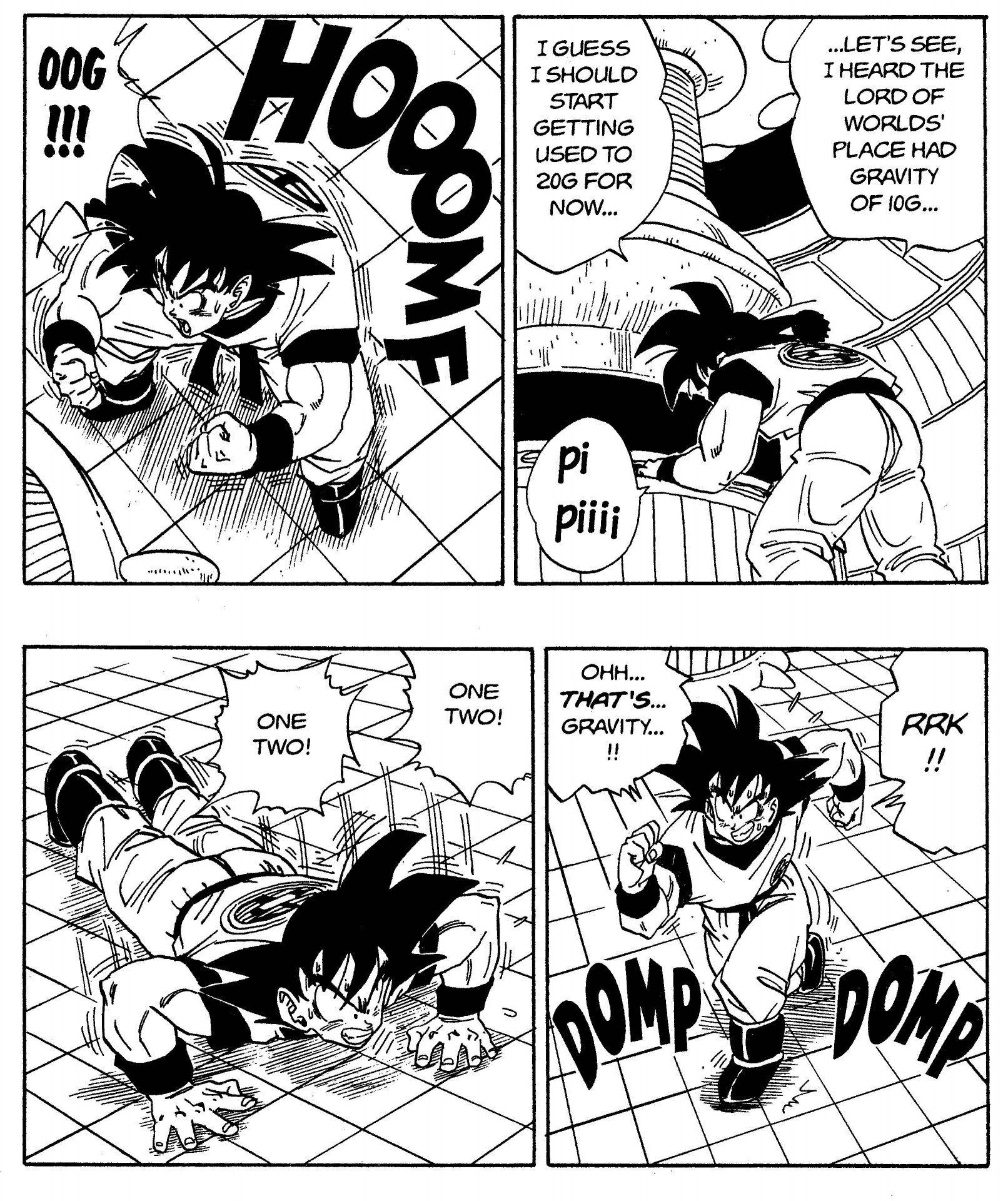
Goku diligently conducting his gravity training on the spaceship headed for Planet Namek
Yes, I think that's probably the case. Strictly speaking, you would say that, due to the increased gravity, the neural network in their cerebellums was being optimized more efficiently, since it's the cerebellum that handles the acquisition of motor skills.
I see. While I was reading the manga, I often wondered, "If you lifted up a barbell that's 100 times heavier, wouldn't that be the same as training in 100G?" In other words, I didn't see the need to change gravity since regular weight training would be enough. But listening to your explanation about strengthening the nervous system and the impact that has on training results, I think I can finally accept the need for gravity training!
Which reminds me, since Goku and Vegeta endured gravity training for long stretches of time, do you have any plans to conduct experiments involving long periods of exposure to hyper-gravity?
I'm hoping to conduct such experiments one day, of course. But since hyper-gravity does place a huge toll on the body, I've got a long road ahead of me to turn my plans into a reality. That's why in the past I applied to have experiments conducted in a zero-gravity environment on the International Space Station. I got feedback saying the proposed research was fascinating, but it wasn't accepted on the basis that it would take up too much of the astronauts' time.
Doing training in space would be so fun! It'd feel so much like actually being in Dragon Ball!
Agreed. But it's possible that zero-gravity would have the opposite effect to hyper-gravity, in that your motor skill acquisition simply might not function.
So in stronger gravity, your motor skill acquisition improves. Could you explain in a bit more detail what exactly is happening inside your brain when that occurs?
When you're first exposed to higher gravity, the sensors in your inner ear (semicircular canals) begin outputting at a greater rate than usual, and that signal strongly stimulates your cerebellum.
It's believed that, if you then perform training under those conditions, the increase in the rate of synaptic transmission (cell-to-cell communication mediated by synapses) that's generated in order to minimize movement errors (the difference between the movement you intend and the movement you physically perform) is greater than under normal conditions, which in turn speeds up motor skill acquisition. This is the mechanism that operates in the brain under hyper-gravity conditions which increases your physical abilities. It's also our best explanation of Dragon Ball's gravity training with our current understanding of neuroscience.
To think our understanding has come this far... So, if we can find ways of manipulating synaptic plasticity (changes in synapse function) other than by using high gravity, we might be able to unlock the mysteries of the "ultimate training method", right?!
We are inching closer to unravelling those mysteries. We've actually already found one more way to influence motor skill acquisition—strong light.
Light...?
Yes, light. When we compared neuron activity in the cerebellums of monkeys when exposed to strong light vs under regular conditions, we found that the former led to higher activity. The same was true for goldfish. Following that, when we trained goldfish while exposing them to strong light, we confirmed that, compared to performing identical training in a dark environment, the goldfish were able to learn more and at a faster pace. It was subsequently concluded that strong light positively influences motor skill acquisition.
Interesting. Now that you mention it, the Room of Spirit and Time is completely white, including the sky. It's not mentioned explicitly in the manga, but could you say that this completely white, super-bright environment aided Goku and Vegeta's training by increasing their motor skill acquisition rate?
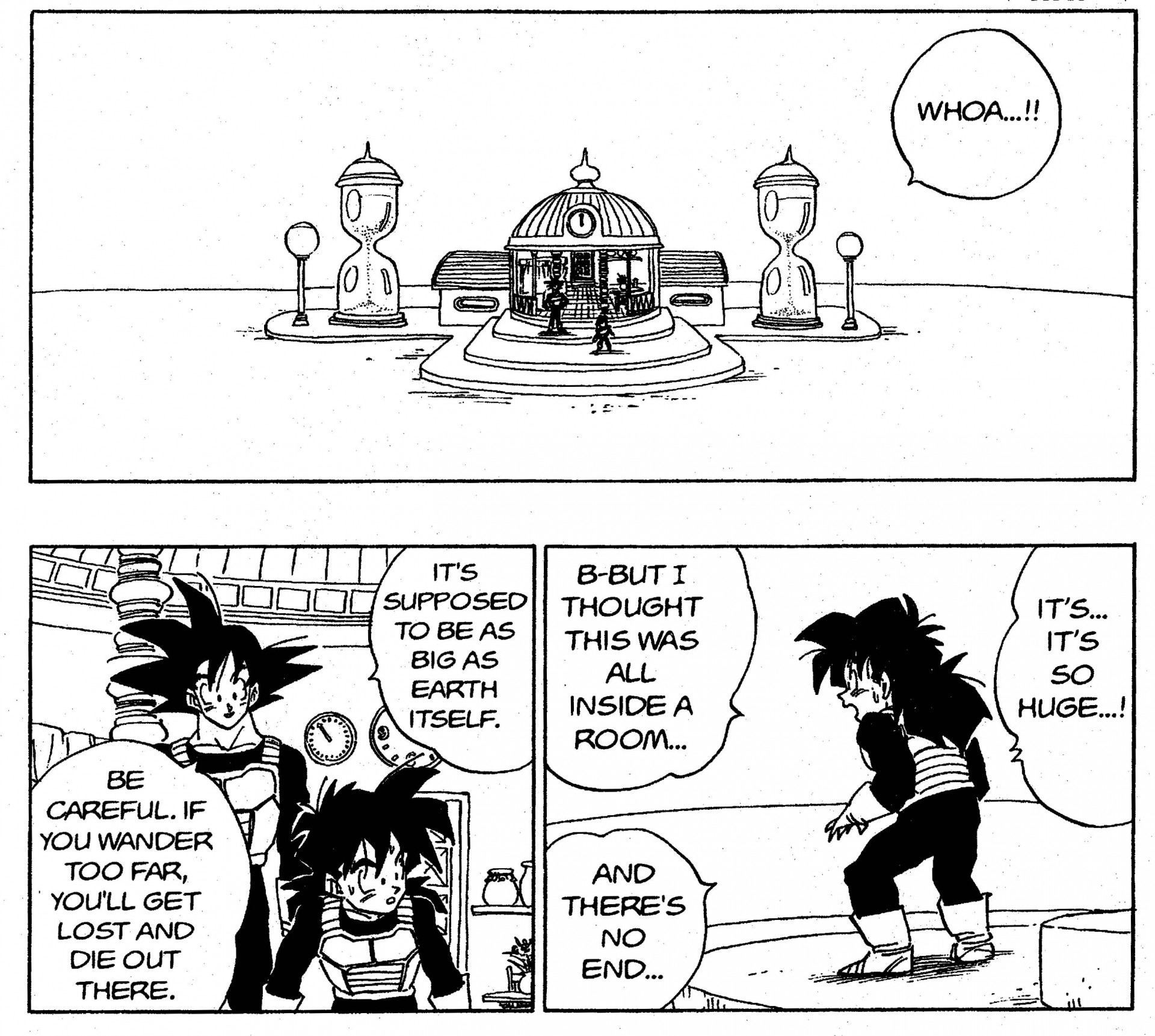
The intensely white Room of Spirit and Time
Definitely. I think you can safely say that their training was more efficient than it would've been had they conducted it in a dimly lit environment.
Using tDCS and TMS may boost training results even further.
What are they exactly?
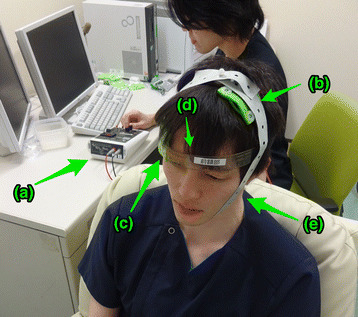
Conducting an experiment using tDCS (Yokoi and Sumiyoshi. 2015/Wikimedia Commons)
Put simply, they're methods of artificially stimulating the brain. tDCS sends a direct electrical current to the brain, whereas TMS uses magnetism, but both stimulate neuron activity so as to increase motor skill acquisition. Actually, these techniques are actively being used in the medical field, such as in aiding physical rehabilitation therapy.
Woah... Could that mean...?
Everything okay?
So by attaching that equipment to your head, your motor skill acquisition improves, right? I think I've just made a pretty cool discovery. Do you remember when Planet Namek's Saichoro used his power to unlock the potential that Krillin had inside him by placing his hand on his head? Well, what if what Saichoro actually did was something similar to tDCS and TMS—like, he was stimulating the neurons in Krillin's cerebellum?!
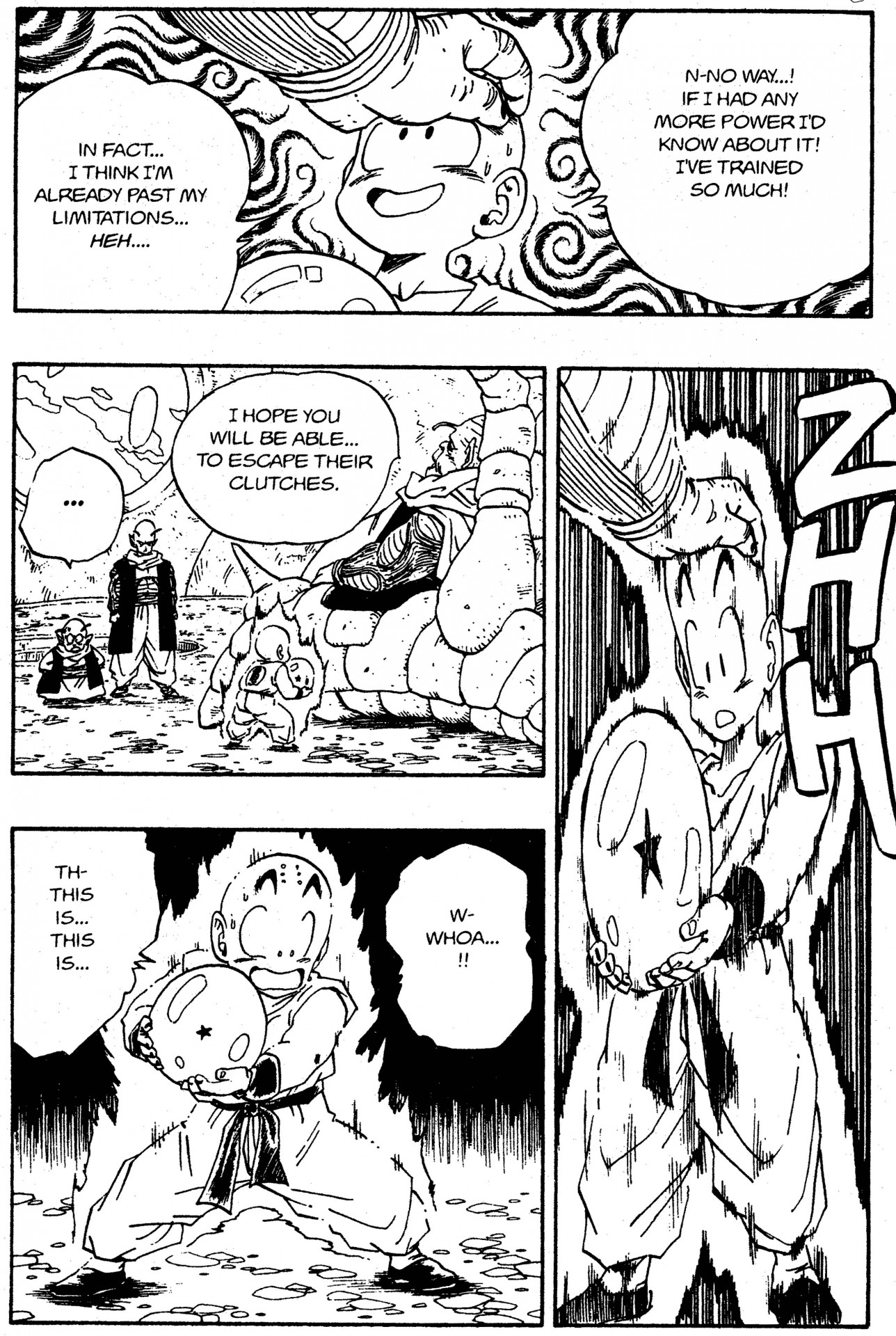
Could Saichoro's power be based on real neuroscience?
Quite possibly. Similar to the equipment, there could be either a direct current or a magnetic field being projected from Saichoro's hand.
No way!! So science has discovered the secret to Saichoro's power!
Although, I suppose since the cerebellum is at the back of head, if he moves his hand further that way, he might get even better results!
Trust the expert to dish out the kind words of advice!
This is a bit of a tangent, but while I've got you here, I simply have to ask you about your relationship with Dragon Ball. While you were conducting your research, where you thinking about Dragon Ball at all?
At the start, I wasn't. But one day, some students younger than myself, who are from a later "Dragon Ball generation", were all excited, saying, "This research is just like those scenes from Dragon Ball!" After that, the thought was in the back of my mind. I even borrowed some of the comics from those students and reread them!
Speaking as a fellow member of the Dragon Ball generation, when I read about your research, I also got a little giddy! Have you been a fan of Dragon Ball since you were young too?
Yes, I'd say so. As a child, I was constantly reading Weekly Shonen Jump. But for people my age, Toriyama was perhaps best known for "Dr. Slump". Dragon Ball first came out when I was in high school.
So you were part of the generation reading it all in real time. Do you have a favorite story arc or character from the time?
I was actually studying shorinji kenpo (a modern Japanese martial art based on shaolin kung fu) back then, so I really liked the Tenkaichi Budokai arcs. My favorite character is Kamesennin. Disguising himself so he could fight against his disciples, endlessly trying to get close to Bulma...he's just a really lovable character.
Well then, I'd say we've delved pretty deep into gravity and its effects on the body so far, but how about we try and give some specifics for the "Ultimate Training" for us humans based on everything we talked about today. First up is high gravity.
Yes, that's right. But just remember that with high gravity there's always the risk of breaking bones and losing consciousness, so the strength has to be kept moderate. Even with just ten times Earth's gravity, things start getting really dangerous. I'm pretty sure jumping with 9 of yourself on your shoulders is impossible for most people.
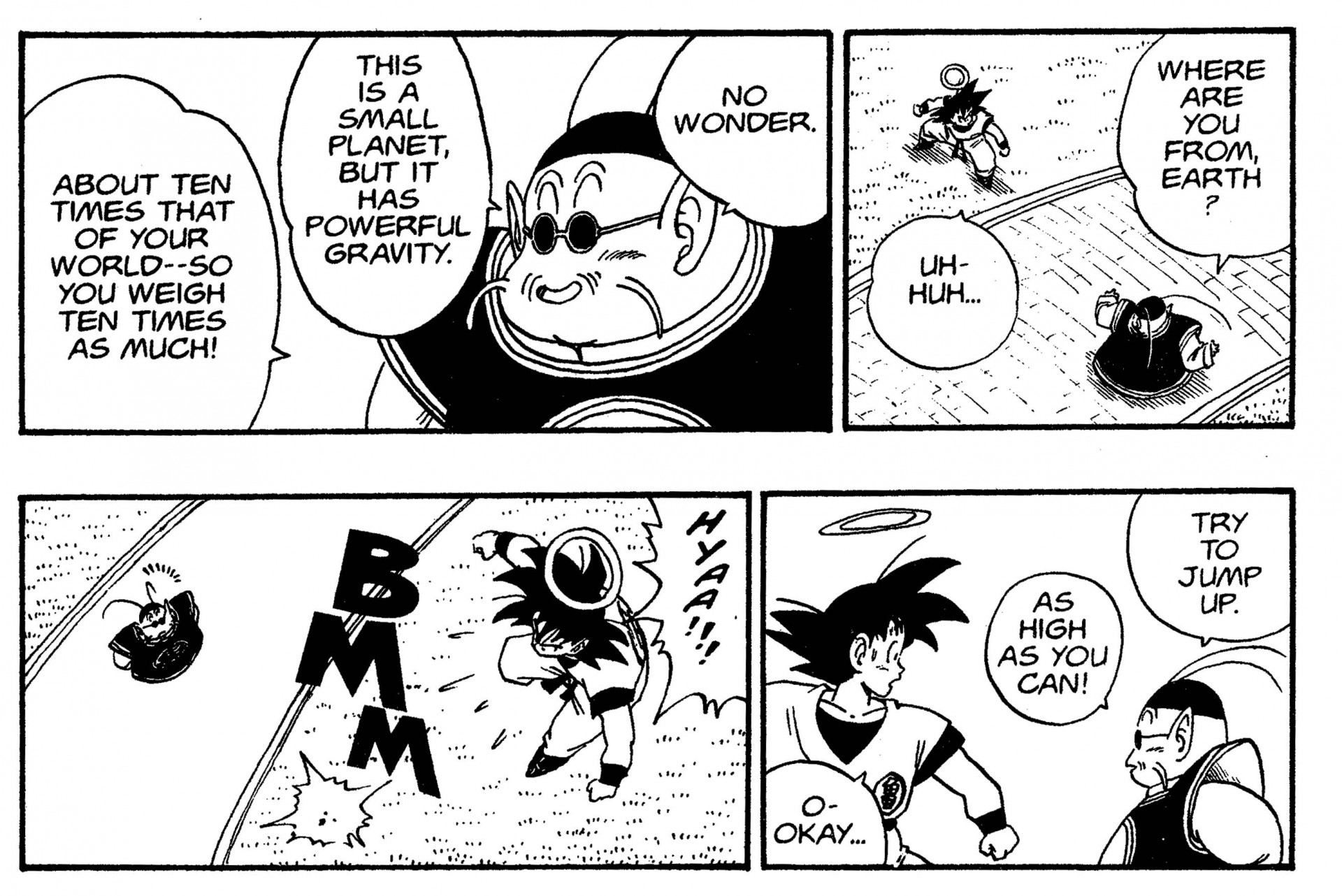
Goku's extreme jumping on the Planet of the Kaio
Then there's strong light.
Yes, training in a super-brightly lit room. Then as a bonus, there's tDCS and TMS, which we discussed earlier.
Gotcha! Training in a bright room, with just the right level of increased gravity,
with some device producing an electric current on your head.
That, to us, might just be the most effective training method.
But then again, if a character with an electric helmet on showed up in shonen manga, they would definitely be the bad guy...!
And that's all for Professor Hirata's enthralling explanation of Dragon Ball's gravity training from the perspective of a neuroscientist.
While his answers were at once deeply fascinating as he recounted the link between gravity and neuroscience, they also helped to shed new light on parts of Dragon Ball that perhaps left you scratching your head a little when you first came across them.
Listening to the professor, there were more than a few times where I was taken aback by the revelation that such seemingly fantastical elements of Dragon Ball could one day leap off the page and into the real world. Discovering new ways that Dragon Ball can ignite one's imagination like this is just one more good reason to give the old classics another read as an adult!
Perhaps the day where athletes, just like Goku before them, can say things like "Alright, let's crank it up to 5G today!", before flicking an artificial gravity switch and training their hearts out is not as far away as you might think!
This site includes machine-translated texts. Please be aware that you might find some unusual expressions that are difficult to understand.
Post
Confirm Post
Post the above comment?
Reply
Confirm Reply
Post the above comment?
Are you sure you want to delete this comment?
Report successful
Post Unsuccessful
This user will be muted.
You will be unable to see comments from muted users in the comments area.
*To unmute users, navigate to the "Comments" area on MY PAGE.
Reply
Confirm Reply
Post the above comment?
Edit
Post


Post
Confirm Post
Post the above comment?
Edit
Post